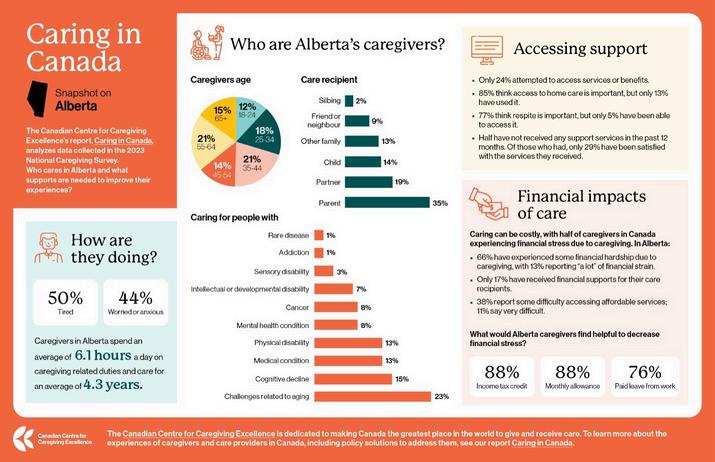
8 minute read
heartheld health
from March 2025
Written By: Vickie Boechler
THE ART OF CAREGIVING: THE BEST KEPT SECRET AND WHAT IT MEANS
Advertisement
Caregiving is an Art
You might say that caregiving is a hidden art that has been practiced throughout the centuries Only when you become a caregiver yourself does one fully realize what caregiving really means; half of all Canadians will be a caregiver at some point in their lives (Canadian Centre for Caregiving Excellence (CCCE), 2024) Their attentiveness, compassion, caring and advocacy is an art
Caregivers are the unacknowledged and unseen foundation of our health care system (CCCE, 2022). More often the focus is on the care recipient such as the disabled child, the man dying with cancer, the young quadriplegic, the aging senior with dementia But without the caregiver where would the care recipient get the care they need in their own home?
According to a Canada wide survey done by CCCE in 2023, Canada is facing a caregiving crisis, caregivers and care recipients are aging, the demand for care is growing, care needs of the care recipient are becoming much more medically complex and the health care system discharges patients earlier than they used to by using clinical practice guidelines with pressure to discharge early (Glette, Kringeland, & Roise, 2019)
CCCEs first policy paper reported that Canada’s public policy did not treat caregivers as an important sector (2022). But now, two years later, the findings of the CCCE National Survey (2024) have added the evidence needed to support a National Caregiving Strategy with policies to be developed in order to eliminate the barriers that caregiver’s face
What is the definition of a Caregiver vs a Care Provider
According to CCCE (2024) caregivers are unpaid family members, friends, or other supports for a person of any age who needs care due to physical, intellectual, or developmental disabilities, medical conditions, mental illness, or needs related to aging. (This definition does not include parents/guardians caring for a healthy well child).
Care providers on the other hand, are trained educated individuals who are paid to provide care to people with physical, intellectual, or developmental disabilities, medical conditions, mental health conditions, or care needs related to aging
Caregiver Responsibilities
There are six domains for caregivers in relation to activities and tasks they are responsible for according to the Committee on Family Caregiving for Older Adults (2016).
1Household tasks includes things like meal preparation, housework, laundry, shopping, transportation, paying bills and grocery shopping
2. Activities of daily living supervision and mobility includes tasks like bathing, getting dressed, feeding self or being fed, toileting, transferring from bed/chair to wheelchair, or just getting in and out of bed with assistance.

3 Emotional and social support is not as easy as doing a task It includes providing companionship, discussions about life, participating in leisure activities, and troubleshooting problems such as family conflict.
4 Health and medical care encourages a healthy lifestyle; care recipient practice self care; dispenses medication, adhering to treatment, wound care, responds to urgent care needs and emergencies.
5 Advocacy and care coordination means facilitating family and provider understanding; making appointments, ordering medication refills, coordinating patient care with service providers like doctors, nurses, social workers, home care aides, and meal delivery.
6 Surrogacy means handling financial and legal matters, advanced care planning, treatment decisions such as surgery, and manages personal property
Barriers Caregivers Face to Provide Care
(Please note that this is not a comprehensive list.)
In a 2021 a research study obtained the needs and challenges of caregivers It was found that the highest priority concerns were caregiving education/training; respite care; financial considerations like workplace flexibility; direct pay for a caregiver and tax policy to benefit caregivers (Tell, Nadash, & Cohen, 2021).
Employed caregivers report that they work an extra shift when caring for someone at home after they have worked all day at their job. They need friendly workplace policies that support their caregiving so they can balance work and home (CCCE, 2024); expanding leaves when emergencies arise. Employed caregivers need improved access to home care; respite services for relief from caregiving to do some selfcare; and have asked for formal training on care responsibilities!
It was found that caregivers’ well being suffers and that the more time spent caregiving the more tired, depressed and overwhelmed they become One in four caregivers report poor or fair mental health (CCCE, 2024) Were they prepared or willing to be a caregiver? According to Dal Pizzol et al (2024), willingness to provide care is linked to the nature of the caregivers relationship with the care recipient . The care recipient has to be prepared to be cared for since the perception of caregiving was found to be perceived as a burden (de Jong et al, 2021)
According to Tell, Nadash, & Cohen (2021), caregivers have found that caregiving creates financial stress on the family unit and is one of the biggest issues they face. Some caregivers end up taking early withdrawals from their retirement savings to meet care-related expenses while other caregivers have to retire early impacting their pensions
SSCE (2024) reported that 22% spend at least $100000 out of pocket each month and only 17% of caregivers receive financial supports Paid care is not working well for caregivers either because they have difficulty finding affordable options (CCCE, 2024)
Strategies Caregivers Need to Break the Barriers
Caregivers Alberta (CA) provides comprehensive strategies that caregivers can use to break the barriers they face. CA has made the biggest impact on caregivers in Alberta since its inception in 2021. It is an excellent program that assists caregivers to excel in caregiving In Alberta, only 24% accessed resources according to the survey (CCCE, 2024) The rest of the caregivers, 76%, are going it alone and need this information to make informed choices
CA is an Alberta wide, registered, charitable, not-for-profit organization that provides easy access to essential services for caregivers, support, and education in order to foster a healthy caregiver community All you have to do is pick up the phone and call them and they will help you CA provides the following extensive nine programs:
1. COMPASS for the Caregiver is a 4 week online interactive series with other caregivers. The other option is the selfpaced one and you do that alone at your own pace
The topics are: Being a Caregiver, Managing your Stress, Balancing Relationships and Navigating the System This workshop series is invaluable and is based on recent evidence and benefits the caregiver I did the self-paced course and was very impressed with the content. There are a lot of topics that hit the spot showing me I wasn’t alone in living the caregiver journey with the care recipient You can register for this learning program online thru Eventbrite
2 A Caregiver Support Line is available: 1-877-453-5088 This telephone help line will get you started on how to help yourself and the care recipient.

3 1-on-1 Caregiver Coaching is available and helps the caregiver plan next steps Sometimes all you need is someone to talk to!
4 System Navigation (wayfinding) is a game changer for the caregiver dyad and helps you access services in the health care system plus a wide variety of other services such as legal, financial and mental health, to name a few. With the recent restructuring of Alberta Health Services all of us will need help in wayfinding resources.
5 Caregiver Support Communities is a peer support group that meets online on a regular basis This way you become part of a support community without having to leave your home if that is a barrier.
6 There are also Peer Support Groups that meet face to face on a regular basis These are so beneficial to a caregiver – to know there are people out there facing the same issues and be able to discuss ways of coping or just get some questions answered.
7 Living with Grief and Loss is a multi-session program that helps the caregiver through loss and grief The caregiver has many losses the most significant being the loss of independence she/he once had The relationship with the care recipient has changed and there is grieving associated with that too. The care recipient has had a lot of loss -their health and especially their independence.
8 Workshops and Education Sessions are presented on a variety of topics such as Lunch ‘n Learn & finding respite for yourself and more. These sessions give you tools to live by and help the caregiving dyad
9 The Work & Care Employer Program supports caregivers where they work for those that have two shifts (one at work and one at home)-email support@caregiversalberta.ca for more information about this extensive program With the prediction that we are headed for a caregiving crisis this is a timely program On average in Alberta, employed caregivers spend 61 hours a day on caregiving after they come home from work and the average time this lasts are 43 years - a long time (CCCE, 2024)
Resolving Financial Hardship
In Alberta, we have provincial home care (call 780-496-1300 for self referral) Where 85% think that home care is important, only 13% have used it!
Other resources are self-managed care (where you sub-contract services yourself for the care recipient); aids to daily living (medical supplies like grab bars, walkers, wheelchairs etc); income supports, benefits, tax credits and deductions
And still, 88% of Albertans would like to see an income tax credit, 88% ask for a monthly allowance to be created, and 76% of Albertans would like paid leave from work (CCCE, 2024) According to the survey more than half of caregivers (52%) are not familiar with tax credits related to care, and that only 1 in 10 caregivers has sought out information about financial help. These statistics show that sharing information on available resources is more important than ever.
Timely Access to Mental Health Support
Four out of five caregivers said they need immediate access to free mental health supports and family counselling. When a crisis looms, a wait list does not work so the only option is to go to Emergency.
There are Mental Health crisis lines and a crisis team who will go out to the home if deemed necessary

Respite Care
Note:TheInfographicstatistics arespecifictoAlberta:from CaringinCanadaSurvey(2024)
Source:CanadianCentrefor CaregivingExcellence(2024) CaringinCanada
Respite is one of the most important ways to practice self-care and was a strategy I used to help the caregivers on my home care caseload. Respite provides a temporary period of relief. That can be reading a book, going for coffee with a friend, a weekend away, a dedicated afternoon once a week, a grocery shopping- banking trip; it can look like many things but gives the caregiver a break and something to look forward to on a regular basis
In Alberta, 77% think that respite is important but only 13% have used it (CCCE, 2024) There is a great deal of marketing that needs to happen so that caregivers learn to use the excellent resources already available The Tri- Municipal Region (2017) has also produced an excellent FCSS Caregivers Resource Guide providing information that is local to Stony Plain, Spruce Grove and Parkland County.
In summary, Canada’s health care system could not function without informal caregivers. The evidence has been presented! Caregiving is the next frontier of public policy in Canada (CCCE, 2022) We must get the National Strategy for Caregiving in place with policies to support caregivers with Canada facing a caregiver crisis (CCCE, 2024)!
Disclaimer:TheinformationinthisarticlewaspreparedbyVickieBoechlerBScN,MNandisintendedforinformationpurposes only,nottogiveheathadvice.Thisinformationdoesnotreplacethehealthadviceofaphysicianoranyotherhealthcare professional.
References: CanadianCentreforCaregivingExcellence(2024) CaringinCanada:SurveyinsightsfromcaregiversandcareprovidersacrossCanada CanadianCentreforCaregiving Excellence,CCCE Caring-in-Canadapdf;AccessedonlineJanuary30,2025 CaregiversAlberta(ND) Programsandservicesforcaregiver’sbrochure Caregiversalbertaca CommitteeonFamilyCaregivingforOlderAdults (2016)BoardonHealthCareServices;HealthandMedicineDivision;NationalAcademiesofSciences,Engineering,and Medicine;SchulzR,EdenJ,editors FamiliesCaringforanAgingAmerica FamilyCaregivingRolesandImpacts;Washington(DC):NationalAcademiesPress(US);Chapter3; AccessedonlineFebruary1 2025 DalPizzol,F,O’Rourke,H,Olson,J,Baumbusch,J,&Hunter,K (2024) Themeaningofpreparednessforinformalcaregiversofolderadults:Aconceptanalysis;Journalof AdvancedNursing-WileyOnlineLibrary;AccessedonlineFebruary1,2025 deJong,L,Stahmeyer,J T,Eberhard,S,Zeidler,J,&Damm,K (2021) Willingnessandpreparednesstoprovidecare:Interviewswithindividualsofdifferentagesandwith differentcaregivingexperiences BMCGeriatrics,21(1),207 https://doiorg/101186/s12877-021-02149-2#citeas;AccessedonlineFebruary1,2025 Glette,M,Kringeland,T,&Roise,O (2019) Hospitalphysicians’viewsondischargeandreadmissionprocesses:aqualitativestudyfromNorway-PMCBMJOpen 2019Aug 27;9(8):e031297 doi:101136/bmjopen-2019-031297;AccessedonlineJanuary30,2025 Tell E Nadash P &Cohen M (2021) Whatfamilycaregiversneed:Findingsfromlisteningsessions AccessedonlineFebruary1 2025 Tri-MunicipalRegion (2017) FCSS-Caregivers-Resource-Guidepdf;AccessedonlineFebruary1,2025






